Electricity - Class 10th Science
NCERT Exercise Solution-2
Question: 12. Several electric bulbs designed to be used on a 220 V electric supply line, are rated 10 W. How many lamps can be connected in parallel with each other across the two wires of 220 V line if the maximum allowable current is 5 A?
Answer:
Given, power = 10W
Potential difference, V = 220 V
Electric current, I = 5A
Here to calculate total number of bulbs, total resistance will be calculated.
We know that,
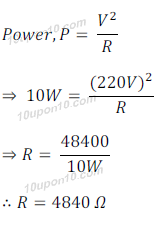
Let, number of bulb connected into parallel = m
Let, total effective resistance, when m bulbs are connected in parallel = R1
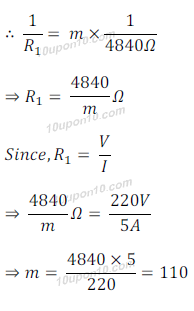
Therefore, total number of bulbs = 110 Answer
Question: 13. A hot plate of an electric oven connected to a 220 V line has two resistance coils A and B, each of 24 Ω resistance, which may be used separately, in series, or in parallel. What are the currents in the three cases?
Answer:
Case : 1: When coil is used separately, then
Resistance, R = 24 Ω and V = 220V
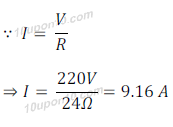
Thus, in this case electric current, I = 9.16 A
Case : 2: When the two resistors are connected in series.
Total effective resistance in the series when coils are used in series= 24 Ω + 24Ω = 48 Ω
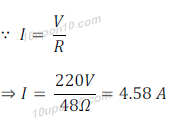
Thus, in this case electric current, I = 4.58 A
Case : 3: When the two resistors are connected in parallel,
Let the total effective resistance = R
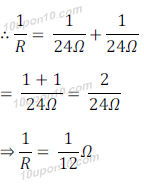
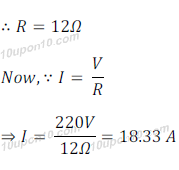
(a) When coil is used separately the electric current (I) = 9.16A
(b) When coils are used in series the electric current (I)= 4.58 A
(c) When coils are used in parallel the electric current (I)= 18.33 A
Question: 14. Compare the power used in the 2 Ω resistor in each of the following circuits:
(i) a 6 V battery in series with 1 Ω and 2 Ω resistors, and
(ii) a 4 V battery in parallel with 12 Ω and 2 Ω resistors.
Answer:
(i) a 6 V battery in series with 1 Ω and 2 Ω resistors
The total effective resitance, R = 1 Ω + 2 Ω = 3 Ω
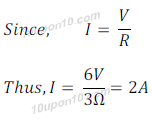
Since, electric current remains the same when resistors are connected in series.
Therefore, electric current through the resistor of 2Ω = 2A
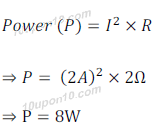
(ii) a 4 V battery in parallel with 12 Ω and 2 Ω resistors
Since, voltage across the circuit remains same if resistors are connected in parallel.
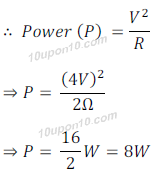
Power used by resistance of 2 Ω in both the case = 8 W
Question: 15. Two lamps, one rated 100 W at 220 V, and the other 60 W at 220 V, are connected in parallel to electric mains supply. What current is drawn from the line if the supply voltage is 220 V?
Answer:
We know that potential difference is not divided in parallel circuit.
Therefore, potential difference remains the same in the circuit = 220V
In the case of bulb having power = 100W
Let Power of one lamp, P1 = 100W
Let Power of second lamp, P2 = 60W
Since the total current drawn in the circuit = Sum of current drawn by each of the device connected in parallel.
Let the total current drawn in the cicuit = I
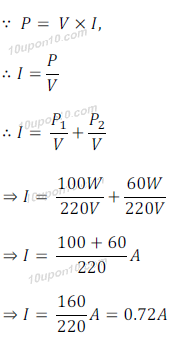
Thus, current of 0.72 A is drawn from the line.
Question: 16. Which uses more energy, a 250 W TV set in 1 hr, or a 1200 W toaster in 10 minutes?
Answer:
We know that, E (energy consumed) = Power x time
In the case of TV
Time = 1 hour = 3600 second
Power of TV = 250W

Thus, energy used by TV = 9,00,000 joule
In the case of toaster
Time (t) = 10 minute = 60 x 10 = 600 s
And power = 1200W

Thus, energy used by toaster = 7,20,000 joule
Thus, TV will use more energy.
Question: 17. An electric heater of resistance 8 Ω draws 15 A from the service mains 2 hours. Calculate the rate at which heat is developed in the heater.
Answer:
Given, Resistance, R = 8 Ω
Electric current ( I ) = 15A
We know that, rate of heat produced = I2R
Thus, rate of heat produced by heater = (15A)2 x 8 Ω
= 225 x 8 J/s
= 1800 Js– Answer
Question: 18. Explain the following.
(a) Why is the tungsten used almost exclusively for filament of electric lamps?
Answer:
The melting point of the filament of electric lamp must be very high, so that it can retain large amount of heat produced with high resistivity.
The melting point of tungsten is 3380⁰C, which is very high. The resistivity of tungsten is 5.2 x 10–8 Ωm, which is also very high. Thus, the high melting point and high resistivity makes tungsten exclusively used for filament of electric lamp.
(b) Why are the conductors of electric heating devices, such as bread-toasters and electric irons, made of an alloy rather than a pure metal?
Answer: Alloys have high melting point and high resistivity than pure metals. Therefore, conductors of the electric heating devices are made of an alloy rather than pure metal.(c) Why is the series arrangement not used for domestic circuits?
Answer: Series arrangement is not used for domestic circuit because of following reasons:- In series circuit the voltage is divided among electrical appliances connected, because of which electric components do not work properly.
- Separate switch cannot be used in series circuit, so it is not possible to use only required components and switched off others.
- Whole line gets disturbed because of malfunction of any one of components.
- Resistance of the component get summed up in series circuit.
(d) How does the resistance of a wire vary with its area of cross-section?
Answer: Resistance is inversely proportional to the area of cross section of wire. This means resistance increases with decrease in area of cross section and vice versa.
(e) Why are copper and aluminium wires usually employed for electricity transmission?
Answer: Copper and aluminium wires usually employed electricity transmission because:
(i) Copper and aluminium have lower resistivity compare to other metals except silver.
(ii) Copper and aliminium are cheaper metal than silver.